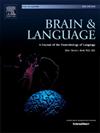Electrophysiological correlates of meaning-based attentional guidance mechanism as a function of cognitive loads in visual search for words
IF 2.3
2区 心理学
Q1 AUDIOLOGY & SPEECH-LANGUAGE PATHOLOGY
引用次数: 0
Abstract
This study investigates the impact of foveal and task-related cognitive loads on meaning-based attentional guidance during visual search for words. Participants searched for words through successive three-words displays while their electroencephalogram was recorded. In target-absent trials, displays contained a central word and two parafoveal words: one distractor semantically-related to the target and one unrelated distractor. To manipulate the task-related cognitive load, participants either searched for specific words either provided beforehand (literal task) or defined only by their semantic category (categorical task). The foveal load was manipulated by varying both the lexical frequency and the semantic-relatedness with the targets of the centered word in the three-words displays. Results indicated that in the literal task, when cognitive load was low, parafoveal distractor words semantically-related to the target triggered faster attentional responses as reflected in increased P2a amplitude, while increasing foveal load delayed parafoveal semantic processing, as shown by N3 and N400 modulations. In contrast, the categorical task, characterized by higher task-related cognitive demands, showed limited evidence of parafoveal semantic processing. Rather, word processing seemed to be focused on deeper processing of central words, as evidenced by N400 variations. Altogether, this work contributes to understanding the interplay between semantic and attentional mechanisms in visual search, highlighting the influence of cognitive resources on visual word processing. Moreover, the findings suggest that covert and overt attention may follow distinct temporal dynamics in parafoveal semantic processing, underscoring the importance of considering task demands and spatial factors when comparing visual search and reading.
视觉词搜索中基于意义的注意引导机制与认知负荷的电生理关联
本研究探讨了视觉词搜索过程中中央凹和任务相关的认知负荷对基于意义的注意引导的影响。参与者通过连续的三个单词显示来搜索单词,同时记录他们的脑电图。在目标缺失试验中,显示包含一个中心词和两个旁中央凹词:一个与目标语义相关的分心物和一个不相关的分心物。为了控制与任务相关的认知负荷,参与者要么搜索事先提供的特定单词(字面任务),要么搜索仅由其语义类别定义的特定单词(分类任务)。中央凹负荷是通过改变三词显示中中心词的词频和与目标词的语义相关性来控制的。结果表明,在文字任务中,认知负荷低时,与目标语义相关的旁中央凹分心词触发的注意反应更快,表现为P2a振幅增加,而增加的中央凹负荷延迟了旁中央凹语义加工,表现为N3和N400调制。相比之下,具有更高任务相关认知要求的分类任务显示出有限的旁中央凹语义加工证据。相反,正如N400变体所证明的那样,文字处理似乎侧重于对中心词的更深层次处理。总之,这项工作有助于理解视觉搜索中语义和注意机制之间的相互作用,突出了认知资源对视觉文字处理的影响。此外,研究结果表明,隐性和显性注意力在旁中央凹语义加工中可能遵循不同的时间动态,这强调了在比较视觉搜索和阅读时考虑任务需求和空间因素的重要性。
本文章由计算机程序翻译,如有差异,请以英文原文为准。
求助全文
约1分钟内获得全文
求助全文
来源期刊

Brain and Language
医学-神经科学
CiteScore
4.50
自引率
8.00%
发文量
82
审稿时长
20.5 weeks
期刊介绍:
An interdisciplinary journal, Brain and Language publishes articles that elucidate the complex relationships among language, brain, and behavior. The journal covers the large variety of modern techniques in cognitive neuroscience, including functional and structural brain imaging, electrophysiology, cellular and molecular neurobiology, genetics, lesion-based approaches, and computational modeling. All articles must relate to human language and be relevant to the understanding of its neurobiological and neurocognitive bases. Published articles in the journal are expected to have significant theoretical novelty and/or practical implications, and use perspectives and methods from psychology, linguistics, and neuroscience along with brain data and brain measures.
 求助内容:
求助内容: 应助结果提醒方式:
应助结果提醒方式:


